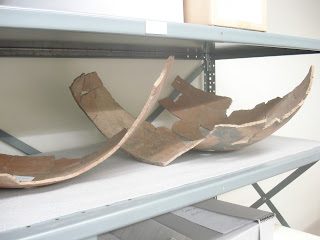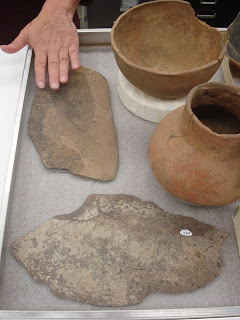What goes into creating or adding to an exhibit? Who selects the objects to be displayed and how does he or she choose? To answer these questions, and many more, I recently spoke with the Curator of Collections at Pueblo Grande Museum, Holly Young, as she selected new pieces from Pueblo Grande’s collections to be added to an exhibit in the Cave Creek Museum from a site called Blue Wash. Pueblo Grande had already loaned the CCM some objects from a personal collection they acquired from a private landowner in Arizona who had Hohokam ruins on his property. This gentleman worked for many years with the Arizona Archaeological Society to recover numerous items from this site. This citizen recently passed away, and so the rest of his personal collection was then donated to the museum. It was from this second part of the collection, Young was selecting new objects to send to the CCM to fill in any gaps they might have in the exhibit and complete the story of the site by expanding their exhibit.
The Blue Wash site is very unique for several reasons. It had stone masonry houses, unlike the houses found at Pueblo Grande, and in one of the houses, archaeologists found a petroglyph on the cornerstone of the structure. This is the only time in domestic Hohokam architecture that a petroglyph has been found. The artifacts from the site are also unique and mostly include ceramic pieces and stone tools like projectile points.
Many of the ceramic pieces are a thousand to eleven hundred years old and are in the Wingfield plain and red styles. The pots were all tempered with shist or phyllite, which is what allowed the Hohokam to create huge jars. Young believes that once these jars were filled, they probably were not moved due to their weight and shape. She also informed me that most ceramic pieces were broken not by being dropped or discarded, but rather by collapsed roofs of the abandoned houses in which they were located. The ceramic jars seemed to break in clean lines and form rectangular shaped sherds. She stated this occurred due to the shist and phyllite, with which the pieces were tempered before being fired. There have also been a lot of technological advances with ceramic materials, new technology such as DNA and trace analysis can detect new information from the pot sherds. At Pueblo Grande, scientists have found traces of chocolate, which confirmed trade between the Hohokam and tribes in Mesoamerica where coco grew. Young stated that she prefers pots and other ceramic pieces to not be thoroughly cleaned or assembled, in many cases, because all glue eventually fails and extensive cleaning destroys possible new discoveries.
![]()
Many of the pieces being considered for the new expansion of the exhibit are stone tools. Young showed me a variety of quarter grooved stone axe heads. It is believed the Hohokam used these tools for heavy woodworking or collecting firewood. The axes are made of very hard stones and were polished from years of chopping wood. They were not particularly sharp, which made it even more impressive to me that the Hohokam used them to fell trees. As one who has difficulty chopping firewood with a sharp ax, I cannot imagine frequently trying to chop down a tree with a dull stone ax in order to build and cook. Other interesting potential pieces for the exhibit included clay balls, stone balls, a stone shaft straightener, and tabular knives/stone hoes used to dig or cut agave. These tools were particularly intriguing because they have serrated edges.
![]()
Young had not decided which objects she will send to the museum when I spoke with her. She still needed to speak with the museum about the logistical aspects of the exhibit, like case sizes, and the personal aspects, like what story or purpose the museum hopes to convey through the exhibit. A lot of thought and planning goes into every exhibit a museum displays, and there is a specific reason behind every single artifact that is shown. It is not as easy as picking out the most intact or most colorful objects. Sometimes a seemingly, boring brown pot shard can reveal more than the most beautiful, whole bowl. To find out what pieces were chosen, go visit the Cave Creek Museum.
Posted by Heather, Pueblo Grande Museum Summer Intern
The Blue Wash site is very unique for several reasons. It had stone masonry houses, unlike the houses found at Pueblo Grande, and in one of the houses, archaeologists found a petroglyph on the cornerstone of the structure. This is the only time in domestic Hohokam architecture that a petroglyph has been found. The artifacts from the site are also unique and mostly include ceramic pieces and stone tools like projectile points.

Many of the pieces being considered for the new expansion of the exhibit are stone tools. Young showed me a variety of quarter grooved stone axe heads. It is believed the Hohokam used these tools for heavy woodworking or collecting firewood. The axes are made of very hard stones and were polished from years of chopping wood. They were not particularly sharp, which made it even more impressive to me that the Hohokam used them to fell trees. As one who has difficulty chopping firewood with a sharp ax, I cannot imagine frequently trying to chop down a tree with a dull stone ax in order to build and cook. Other interesting potential pieces for the exhibit included clay balls, stone balls, a stone shaft straightener, and tabular knives/stone hoes used to dig or cut agave. These tools were particularly intriguing because they have serrated edges.

Young had not decided which objects she will send to the museum when I spoke with her. She still needed to speak with the museum about the logistical aspects of the exhibit, like case sizes, and the personal aspects, like what story or purpose the museum hopes to convey through the exhibit. A lot of thought and planning goes into every exhibit a museum displays, and there is a specific reason behind every single artifact that is shown. It is not as easy as picking out the most intact or most colorful objects. Sometimes a seemingly, boring brown pot shard can reveal more than the most beautiful, whole bowl. To find out what pieces were chosen, go visit the Cave Creek Museum.
Posted by Heather, Pueblo Grande Museum Summer Intern



